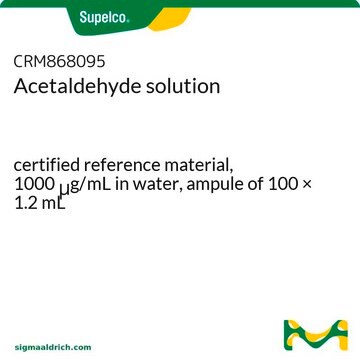All Photos(1)
About This Item
Linear Formula:
CH3CHO
CAS Number:
Molecular Weight:
44.05
MDL number:
UNSPSC Code:
12352100
eCl@ss:
39021102
PubChem Substance ID:
NACRES:
NA.22
Recommended Products
form
liquid
Quality Level
concentration
5 M in THF
refractive index
n20/D 1.389
density
0.868 g/mL at 20 °C
0.843 g/mL at 25 °C
functional group
aldehyde
storage temp.
2-8°C
SMILES string
[H]C(C)=O
InChI
1S/C2H4O/c1-2-3/h2H,1H3
InChI key
IKHGUXGNUITLKF-UHFFFAOYSA-N
Looking for similar products? Visit Product Comparison Guide
Signal Word
Danger
Hazard Statements
Precautionary Statements
Hazard Classifications
Carc. 1B - Eye Irrit. 2 - Flam. Liq. 2 - Muta. 2 - STOT SE 3
Target Organs
Central nervous system, Respiratory system
Supplementary Hazards
Storage Class Code
3 - Flammable liquids
WGK
WGK 3
Flash Point(F)
-25.1 °F - closed cup
Flash Point(C)
-31.7 °C - closed cup
Choose from one of the most recent versions:
Already Own This Product?
Find documentation for the products that you have recently purchased in the Document Library.
Customers Also Viewed
Nikoline Borgermann et al.
The EMBO journal, 38(8) (2019-03-28)
DNA-protein crosslinks (DPCs) are highly cytotoxic lesions that obstruct essential DNA transactions and whose resolution is critical for cell and organismal fitness. However, the mechanisms by which cells respond to and overcome DPCs remain incompletely understood. Recent studies unveiled a
M Becker et al.
Journal of chromatography. A, 1281, 115-126 (2013-02-13)
Gas chromatographic analysis of complex carbohydrate mixtures requires highly effective and reliable derivatisation strategies for successful separation, identification, and quantitation of all constituents. Different single-step (per-trimethylsilylation, isopropylidenation) and two-step approaches (ethoximation-trimethylsilylation, ethoximation-trifluoroacetylation, benzoximation-trimethylsilylation, benzoximation-trifluoroacetylation) have been comprehensively studied with regard
Marjie L Hard et al.
Placenta, 24(2-3), 149-154 (2003-02-05)
Significant interindividual variability exists following maternal alcohol consumption; not all children born to alcoholic women manifest the symptoms associated with foetal alcohol spectrum disorder (FASD). To investigate the potential role of the placenta as a source of variability by determining
Tetsuji Yokoyama et al.
Alcoholism, clinical and experimental research, 29(4), 622-630 (2005-04-19)
Elevated mean corpuscular volume (MCV) is a traditional biological marker for alcohol abuse and alcoholism, but the underlying mechanism is unclear. Three recent epidemiologic studies consistently showed that MCV was elevated by alcohol drinking more markedly among individuals with genetically
Dirk W Lachenmeier et al.
Addiction (Abingdon, England), 104(4), 533-550 (2009-04-02)
In addition to being produced in ethanol metabolism, acetaldehyde occurs naturally in alcoholic beverages. Limited epidemiological evidence points to acetaldehyde as an independent risk factor for cancer during alcohol consumption, in addition to the effects of ethanol. This study aims
Our team of scientists has experience in all areas of research including Life Science, Material Science, Chemical Synthesis, Chromatography, Analytical and many others.
Contact Technical Service






